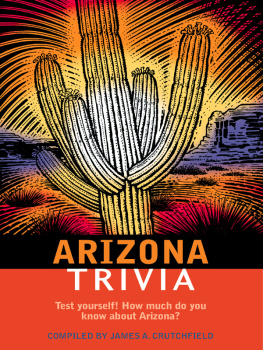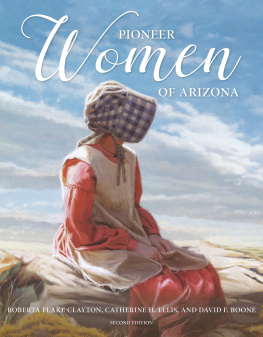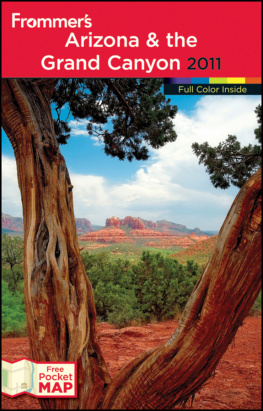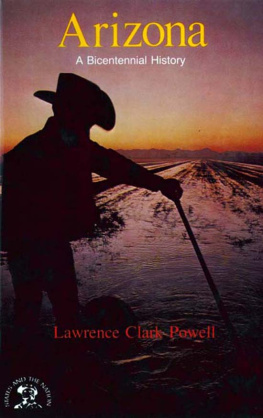About the Author
An insatiable curiosity has led Barbara Marriott down the rabbit hole to some great adventures in the wonderland of book writing. In her checkerboard life, she has done such things as flown with the Blue Angels, created and edited a newspaper on the French Riviera, been a Vogue magazine Prix de Paris finalist, earned a Ph.D. in cultural anthropology, been a management consultant and trainer, been a college professor, and been listed in Whos Who of American Women.
Moving to Arizona eighteen years ago, Marriott turned her wild inquiring mind to the fascinating history of New Mexico and Arizona. She has written eight nonfiction historical books on the Southwest including In Our Own Words: The Lives of Arizona Pioneer Women, Outlaw Tales of New Mexico, and Myths and Mysteries of New Mexico; two works of historical fiction; and two historical nonfiction military books. Her reasoning for this eclectic mix: I get bored easily. She lives in Tucson, Arizona.
TWO SIX SHOOTERS BEAT FOUR ACES
A TWODOT BOOK
An imprint and registered trademark of Rowman & Littlefield
Distributed by NATIONAL BOOK NETWORK
Copyright 2015 by Barbara Marriott
All rights reserved. No part of this book may be reproduced in any form or by any electronic or mechanical means, including information storage and retrieval systems, without written permission from the publisher, except by a reviewer who may quote passages in a review.
British Library Cataloguing-in-Publication Information available
Library of Congress Cataloging-in-Publication Data
Marriott, Barbara.
Two six shooters beat four aces : stories of a young Arizona / Barbara Marriott.
pages cm
Includes bibliographical references and index.
ISBN 978-1-4422-4731-4 (pbk.)ISBN 978-1-4422-4732-1 (ebook) 1. ArizonaHistory Anecdotes. 2. ArizonaBiographyAnecdotes. 3. Frontier and pioneer lifeArizonaAnecdotes. I. Title.
F811.6.M37 2015
979.1dc23
2015012471
 The paper used in this publication meets the minimum requirements of American National Standard for Information SciencesPermanence of Paper for Printed Library Materials, ANSI/ NISO Z39.48-1992.
The paper used in this publication meets the minimum requirements of American National Standard for Information SciencesPermanence of Paper for Printed Library Materials, ANSI/ NISO Z39.48-1992.
For Gene and Irwin Pellerin, John and Geri Redling, and Kathy and Tom Steckler, who fill the road of life with laughs and love.
Acknowledgments
No author writes alone. Behind him or her, there is an army of supporters, helpers, informants, well-wishers, and production people. That is especially true in nonfiction. First thanks go to Melanie Sturgeon from the Arizona State Library, Archives, and Public Records, who made the Federal Writers Project papers available. Thank you God for Erin Turner, who is one of the fairest and best editors in the business, and thanks to my right-hand-man Mike, who supplies transportation, opinions, and the correct spelling. When encouragement is needed, when the writing path is gloomy or nonexistent, Jan Cleere, author and friend, always has the right words, the best advice, and the most cheerful smile. Lets do lunch! We do, and it lasts until dinnertime. Barbara Akins is my cheerful and efficient partner at book fairs. Her professional manner takes a lot of stress away from me, and I dont know how, but she manages to organize chaos. Oh, how I appreciate you. There are not enough thanks and appreciation I can lay on my family, Bill and Candy Marriott, Minette and Mike Shook, and the grand-adults: Tyler, Casey, and Matt and the newest additions, Katie and Brandon... they are always there for me.
Introduction
Alpine Valleys, scorching deserts, and broken mountain chains... ruled by the most vindictive and warlike of all Redmen, the Apaches...
CHARLES DEBRILLE POSTON
THE HISTORY AND POLITICS OF 1800 ARIZONA
In the early 1800s, the southwest lands had little appeal for most Americans. In 1851, Charles Debrille Poston, considered by many to be the father of Arizona, described the land as having great rivers that over drained the land. Poston noted that the diverse topography of Alpine valleys, scorching deserts, and broken mountain chains provide a varied climate. He added that the land was ruled by the most vindictive and warlike of all Redmen, the Apaches, and there is no settlement east or west, between the Colorado and the Rio Grande rivers. While colorful, and somewhat accurate, Postons statement totally ignored the small Mexican pueblos in the territory.
Although Poston thought little of the land, he did have the honor of naming the territory. When the attorney general of New Mexico sent a petition to Congress asking for separation of the government land between Colorado and the Rio Grande Rivers (now Arizona and New Mexico), Poston suggested the name Arizona, from the Aztec word Arisuma, meaning rocky country.
There were a few white men living in the territory; most of them had fled justice in other states or territories. However, they were soon to learn that there was no sanctuary in the sparsely populated Mexican villages. The Mexicans took out their frustrations with their government, and their resentment of the United States, through lawlessness. As Poston put it, It was the reign of the revolver. You had to carry a knife and a gun for your life. Men only lived if they were quicker on the draw.
This land came to the attention of the American public in 1836. An area of northern Mexico, called Texas, wanted independence and freedom from Mexican control. That year, after a series of skirmishes, the Texans finally gained their independence. It came at a cost of many lives, including the men lost in the devastating fight at an obscure mission, where the Texan rallying battle cry of Remember the Alamo was born.
Mexico did not give up the Texas land willingly. They continued to encourage border raids. Then, in a threat to the United States, they warned that any attempt at annexing Texas would lead to war.
American president James Polk saw the situation differently. He was on a political path of manifest destiny, believing America had the right, almost the duty, to spread its boundaries from sea to sea. He saw the annexation of Texas as a step in that direction. The implied economic benefits of expanding the borders across the continent were enormous, especially after the discovery of gold in California.
Polk offered to purchase the coveted land from Mexico. When they refused, he moved troops into the zone between the Rio Grande and Nueces Rivers. There, on April 25, 1846, a troop of Mexican cavalry attacked the encamped soldiers, killing almost a dozen. The Mexican soldiers went on to mount another attack against an American fort on the Rio Grande. That was all the excuse Polk needed to pressure Congress into declaring war.
Meanwhile, long after the Conquistadors had come and gone, another religious movement was to play an important historic role in this southwest land. Unlike the Franciscan and Jesuit priests, from the 1500s and 1600s, this religious group was not looking to co-op those who lived on the land, nor did they seek to rape the land of its riches. What they wanted was protection for their people, room to expand, and lands to increase the value of their financial base.
Just expelled from Nauvoo, Illinois, for practicing polygamy, the Church of Jesus Christ of Latter-day Saints (Mormons), were seeking a new home for their religious base. Brigham Young, president of the Quorum of the Twelve Apostles, had repeatedly asked the US government for assistance and protection, which were never granted.
Faced with war; the protection of a vast, mostly unexplored land; and the need to bind a group of people headed for rebellion, President Polk conceived a plan that would benefit both the United States and the Mormons. Polk did not want the Mormons to join forces with Mexico, and he needed a show of force in the Southwest Territory. Knowing Mexico would attempt to annex California, Polk wanted more troops in that area. The Presidents goal was to bind the Mormons loyalty to America and establish the countrys claim to the southwest territory. Through negotiations, the two parties reached a compromise.







 The paper used in this publication meets the minimum requirements of American National Standard for Information SciencesPermanence of Paper for Printed Library Materials, ANSI/ NISO Z39.48-1992.
The paper used in this publication meets the minimum requirements of American National Standard for Information SciencesPermanence of Paper for Printed Library Materials, ANSI/ NISO Z39.48-1992.